Siem Reap on:
[Wikipedia]
[Google]
[Amazon]
Siem Reap ( km, សៀមរាប, ) is the second-largest city of
 The name "Siem Reap" can be translated to mean 'defeat of
The name "Siem Reap" can be translated to mean 'defeat of 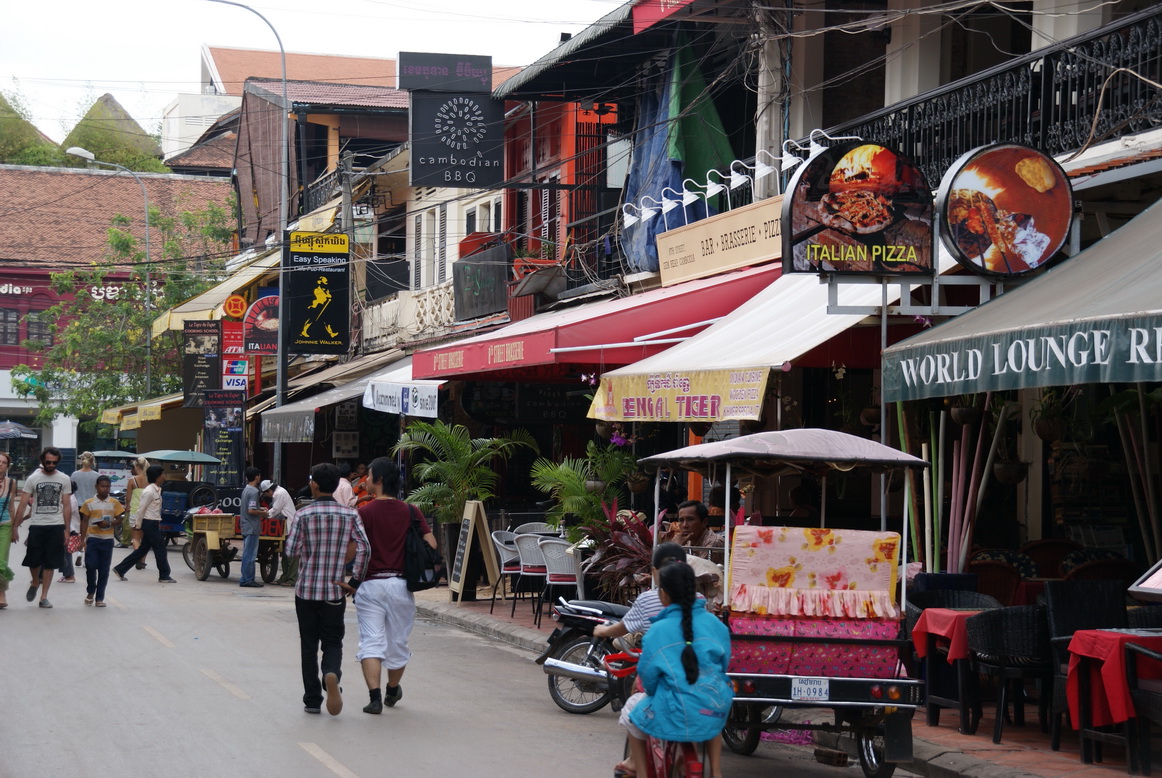 In reality, surviving historic sources make this derivation appear unlikely, since they date the decline of Angkor to more than a century before this, when a military expedition from Ayutthaya captured and sacked Angkor Wat, which began a long period of vassal rule over Cambodia. The 1431 capture coincided with the decline of Angkor, though the reasons behind its abandonment are not clear. They may have included environmental changes and failings of the Khmer infrastructure.
From the 16th to the 19th centuries, infighting among the Khmer nobility led to periodic intervention and domination by both of Cambodia's more powerful neighbors, Vietnam and Siam. Siem Reap, along with
In reality, surviving historic sources make this derivation appear unlikely, since they date the decline of Angkor to more than a century before this, when a military expedition from Ayutthaya captured and sacked Angkor Wat, which began a long period of vassal rule over Cambodia. The 1431 capture coincided with the decline of Angkor, though the reasons behind its abandonment are not clear. They may have included environmental changes and failings of the Khmer infrastructure.
From the 16th to the 19th centuries, infighting among the Khmer nobility led to periodic intervention and domination by both of Cambodia's more powerful neighbors, Vietnam and Siam. Siem Reap, along with
 Siem Reap was little more than a village when French explorers such as Henri Mouhot "re-discovered" Angkor in the 19th century. However, European visitors had visited the temple ruins much earlier, including António da Madalena in 1586. In 1901, the
Siem Reap was little more than a village when French explorers such as Henri Mouhot "re-discovered" Angkor in the 19th century. However, European visitors had visited the temple ruins much earlier, including António da Madalena in 1586. In 1901, the 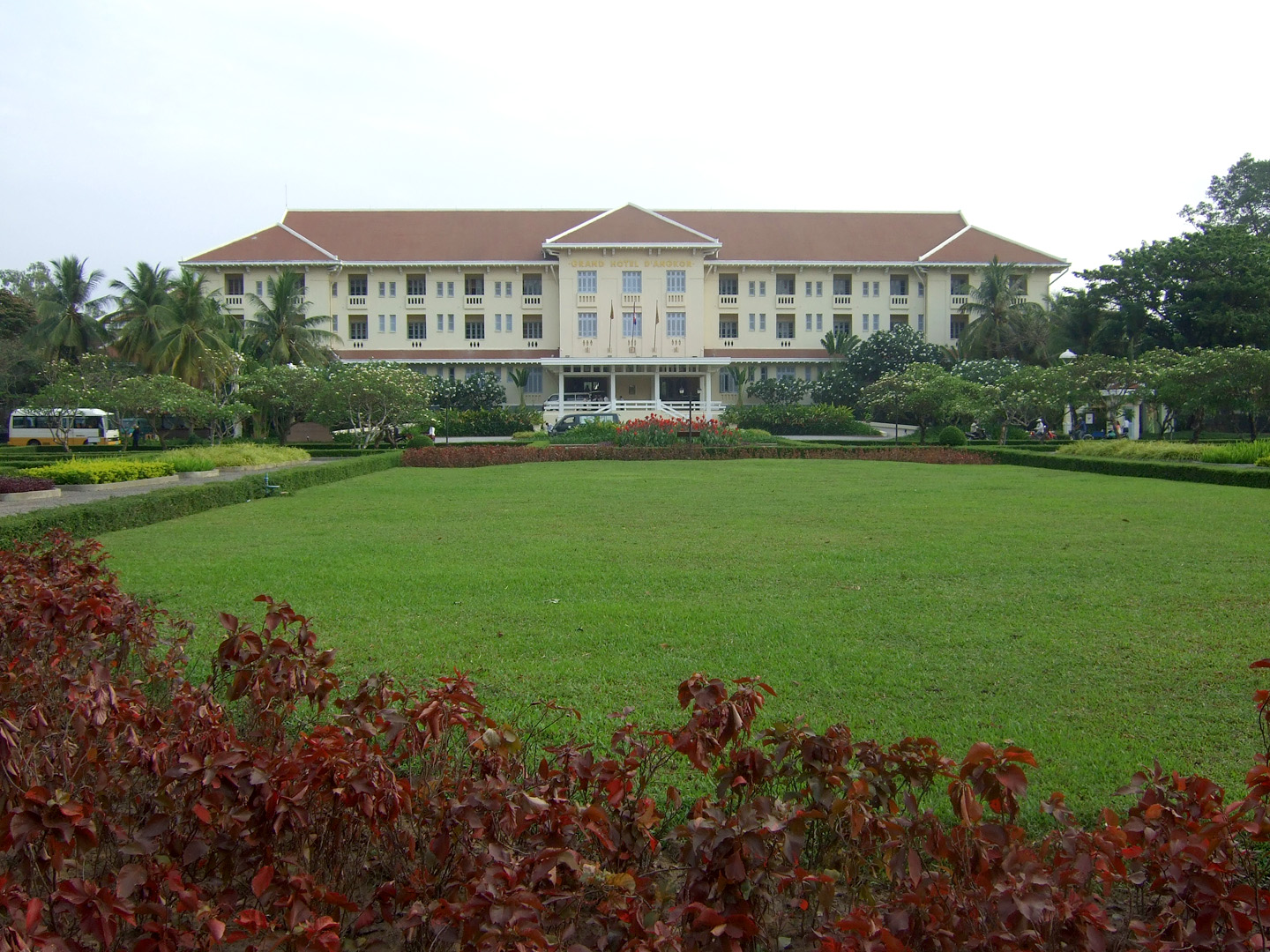 With the acquisition of Angkor by the French in 1907 following a Franco-Siamese treaty, Siem Reap began to grow. The Grand Hotel d'Angkor opened in 1929 and the temples of Angkor became one of Asia's leading draws until the late-1960s, when civil war kept tourists away. In 1975, the population of Siem Reap, like all other Cambodian cities and towns, was driven into the countryside by the communist
With the acquisition of Angkor by the French in 1907 following a Franco-Siamese treaty, Siem Reap began to grow. The Grand Hotel d'Angkor opened in 1929 and the temples of Angkor became one of Asia's leading draws until the late-1960s, when civil war kept tourists away. In 1975, the population of Siem Reap, like all other Cambodian cities and towns, was driven into the countryside by the communist 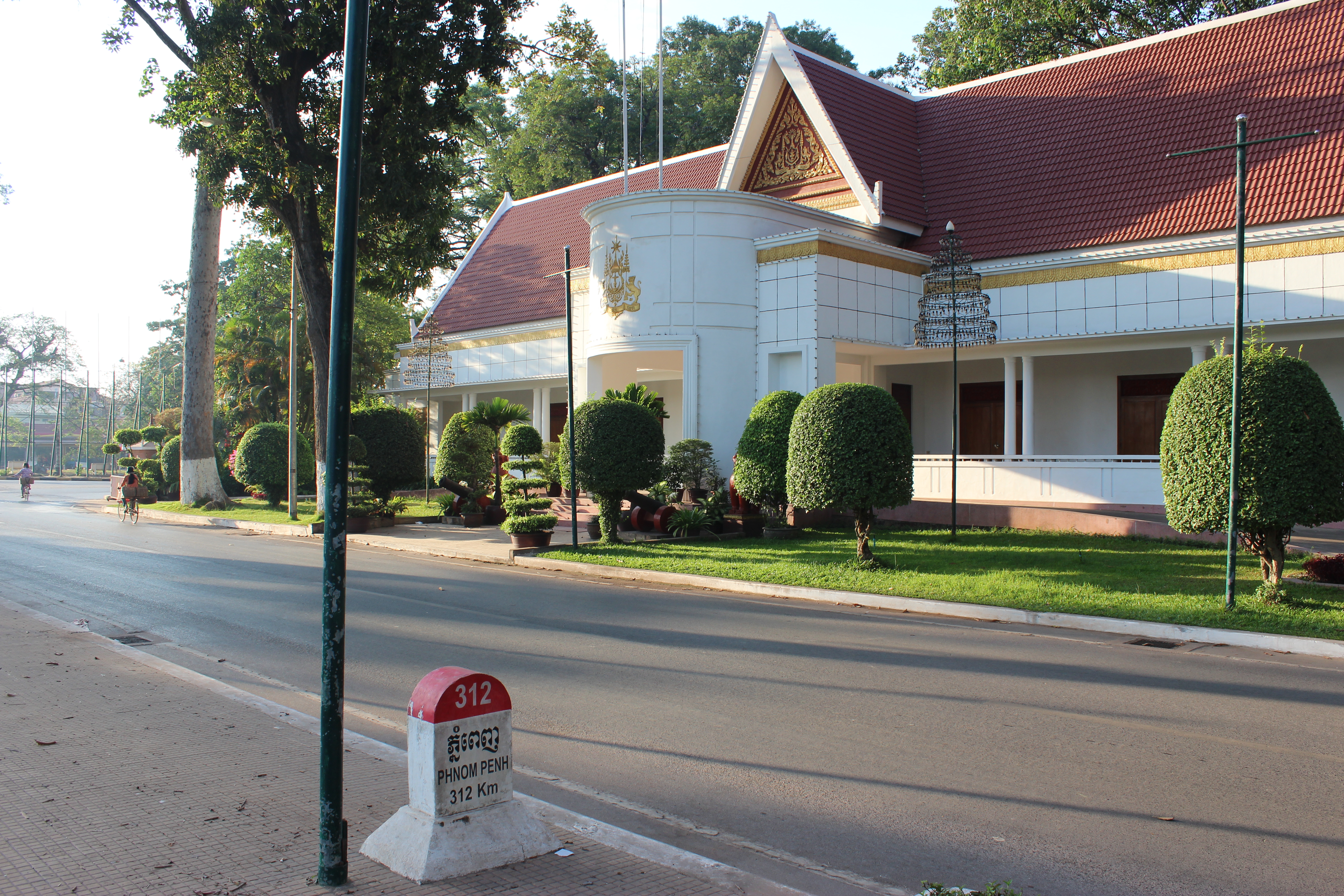 Siem Reap now serves as a small gateway town to the world heritage site of Angkor Wat. In recent years, the city has regularly ranked in the top ten for "Best Destination" lists produced by entities such as TripAdvisor, ''Wanderlust Magazine'', and ''Travel+Leisure''.
Siem Reap now serves as a small gateway town to the world heritage site of Angkor Wat. In recent years, the city has regularly ranked in the top ten for "Best Destination" lists produced by entities such as TripAdvisor, ''Wanderlust Magazine'', and ''Travel+Leisure''.
 Siem Reap is a cluster of small villages along the Siem Reap River. These villages were originally developed around
Siem Reap is a cluster of small villages along the Siem Reap River. These villages were originally developed around
 Tourism is a very important aspect of the economy of Siem Reap – it was estimated in 2010 that over 50% of jobs in the town were related to the tourism industry. The city has seen a massive increase in tourist exchange in the couple of decades after the end of the
Tourism is a very important aspect of the economy of Siem Reap – it was estimated in 2010 that over 50% of jobs in the town were related to the tourism industry. The city has seen a massive increase in tourist exchange in the couple of decades after the end of the
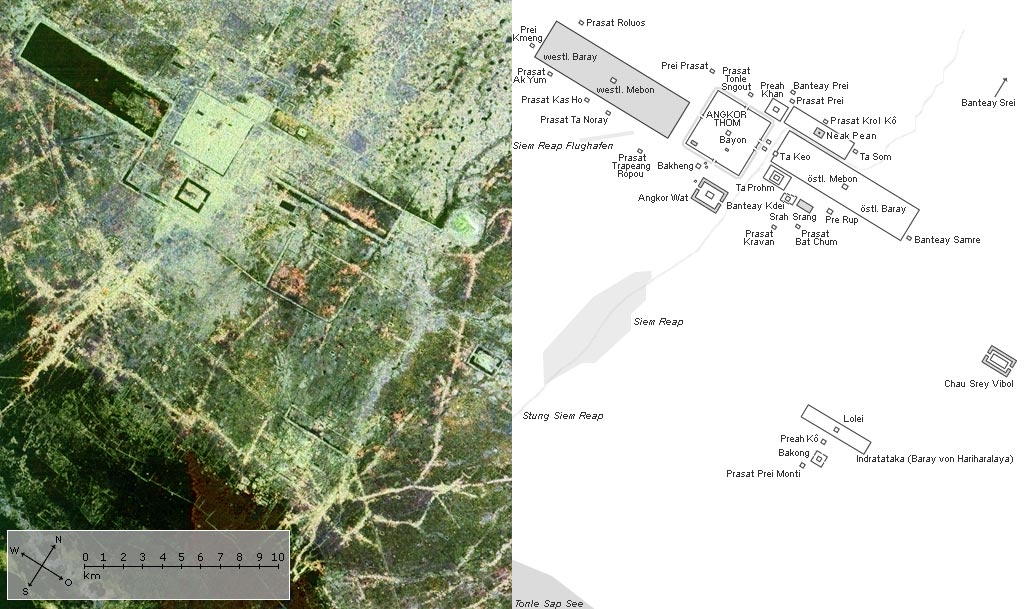
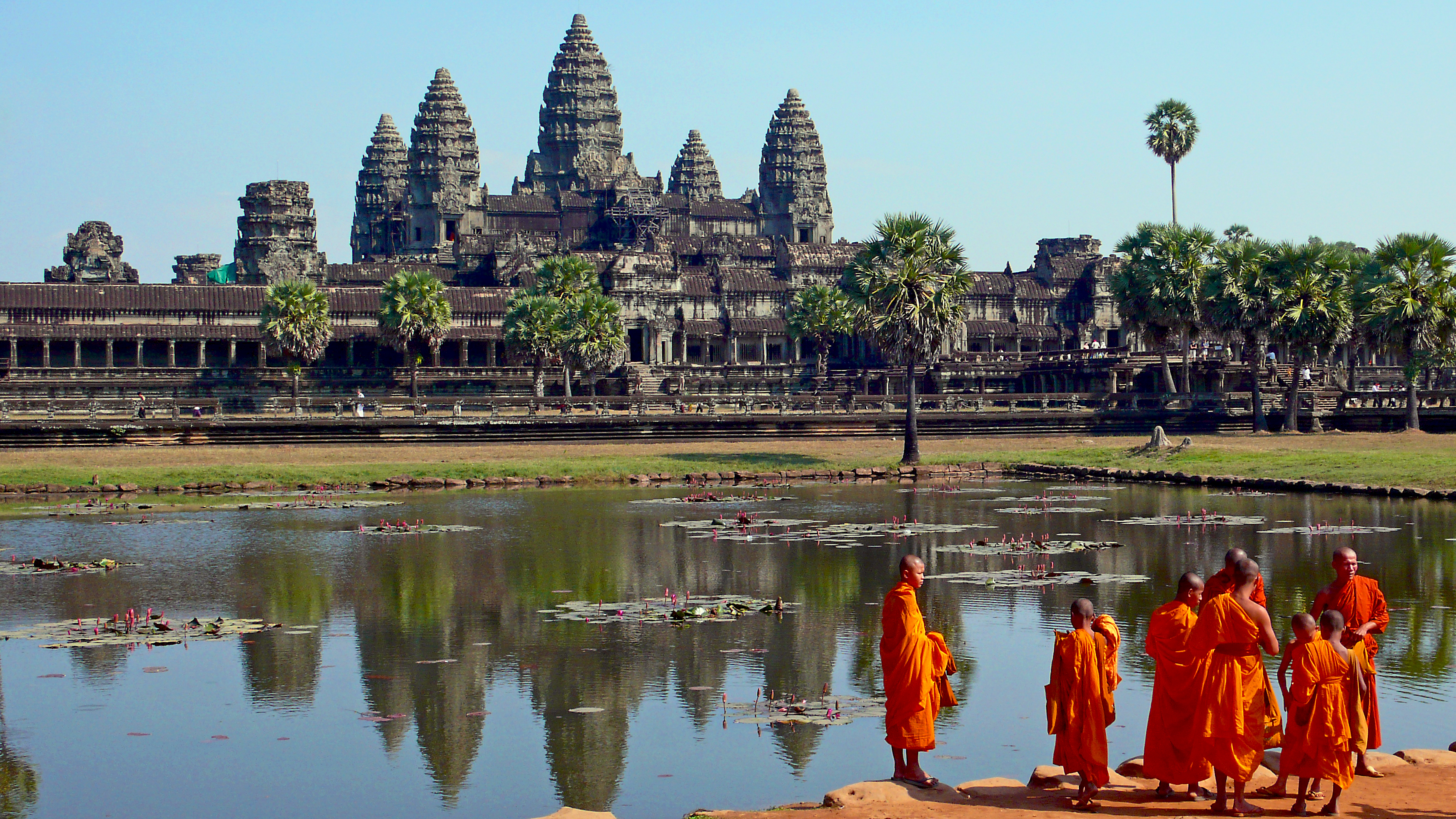 Angkor Wat ( Wat temple) is the central feature of the Angkor
Angkor Wat ( Wat temple) is the central feature of the Angkor
 Angkor Thom is an inner royal city built by Jayavarman VII, the Empire's famed 'Warrior King', at the end of the 12th century and is renowned for its temples, in particular the Bayon. Other notable sites are Baphuon, Phimeanakas, the
Angkor Thom is an inner royal city built by Jayavarman VII, the Empire's famed 'Warrior King', at the end of the 12th century and is renowned for its temples, in particular the Bayon. Other notable sites are Baphuon, Phimeanakas, the
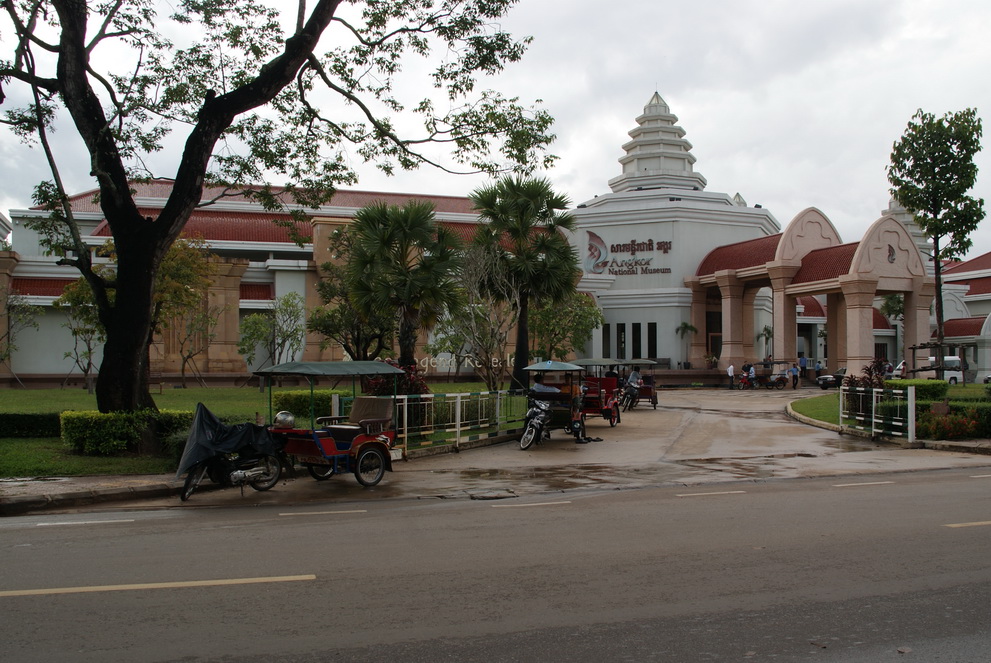
 The Old Market or
The Old Market or 

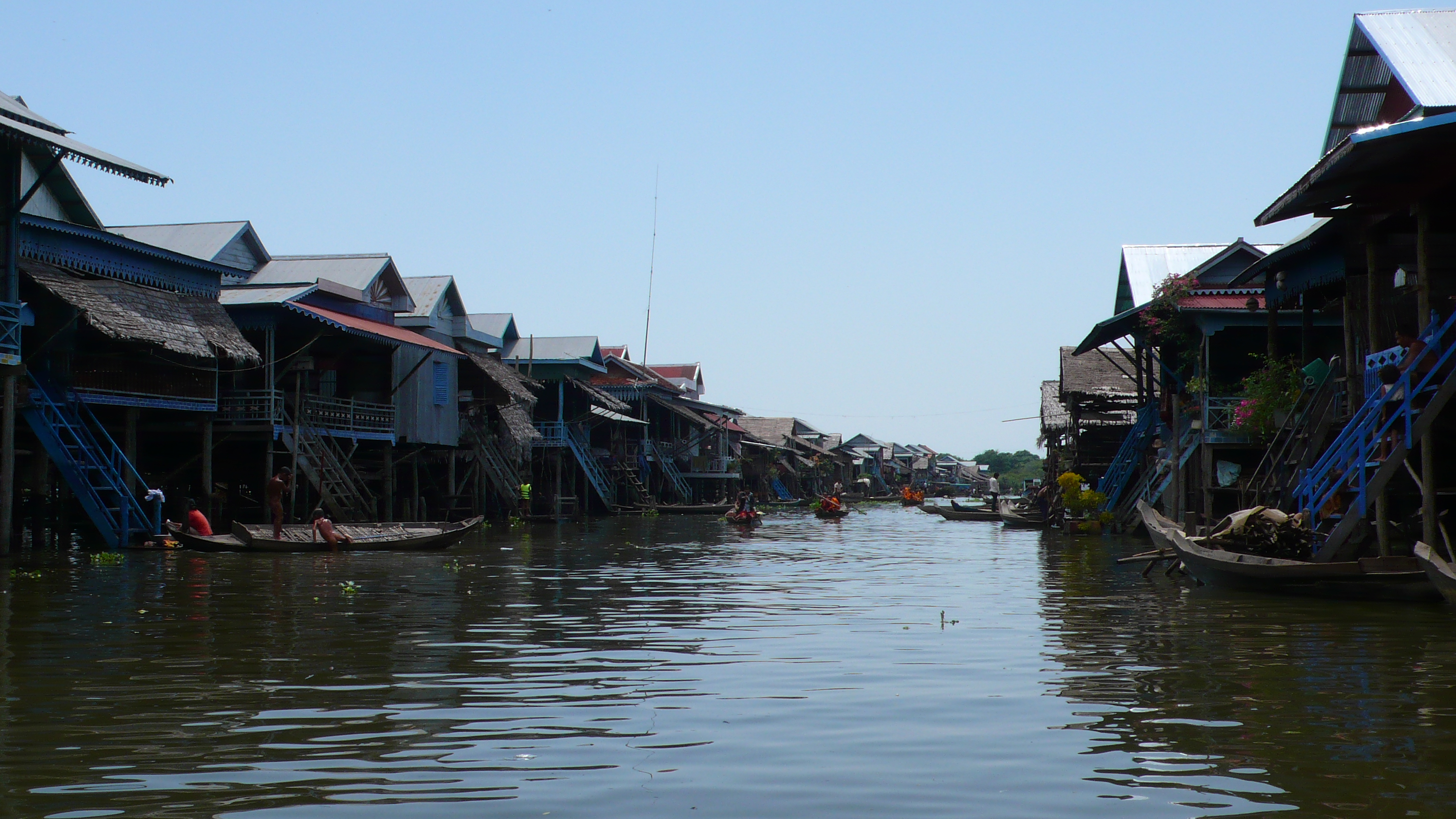
Kompong Khleang
is considered the largest and most authentic, and Chong Kneas the least authentic but most visited due to its proximity to the city.


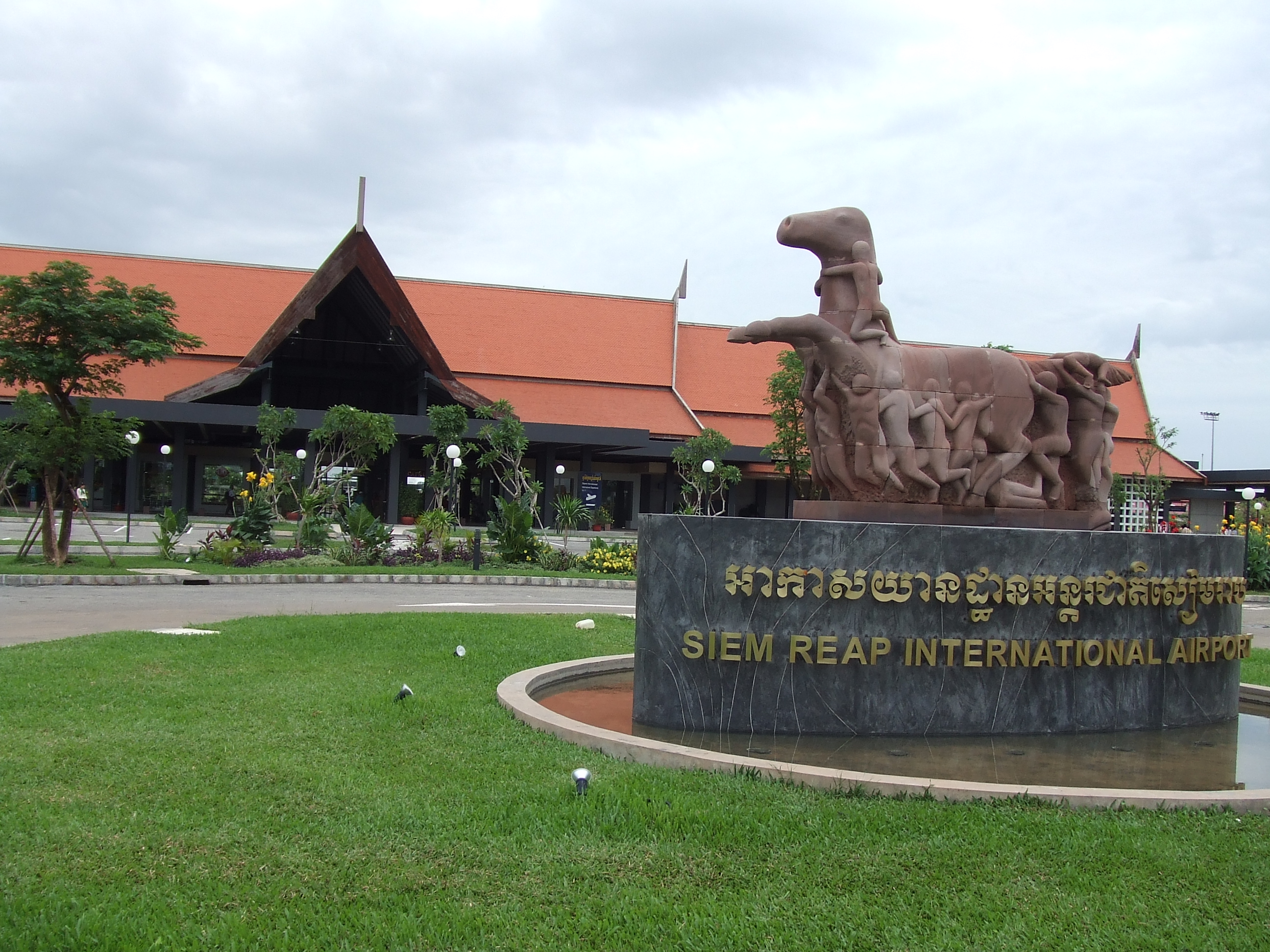 The city is from Siem Reap International Airport, and is accessible by direct flights from many Asian cities, and by land from Phnom Penh and to the Thai border. It is also accessible by boat (via Tonle Sap lake). There are also buses from
The city is from Siem Reap International Airport, and is accessible by direct flights from many Asian cities, and by land from Phnom Penh and to the Thai border. It is also accessible by boat (via Tonle Sap lake). There are also buses from  It is possible to get from
It is possible to get from
Official Siem Reap website
* * {{Authority control Cities in Cambodia Populated places in Siem Reap province Provincial capitals in Cambodia
Cambodia
Cambodia (; also Kampuchea ; km, កម្ពុជា, UNGEGN: ), officially the Kingdom of Cambodia, is a country located in the southern portion of the Indochinese Peninsula in Southeast Asia, spanning an area of , bordered by Thailand ...
, as well as the capital and largest city of Siem Reap Province in northwestern Cambodia
Cambodia (; also Kampuchea ; km, កម្ពុជា, UNGEGN: ), officially the Kingdom of Cambodia, is a country located in the southern portion of the Indochinese Peninsula in Southeast Asia, spanning an area of , bordered by Thailand ...
.
Siem Reap has French colonial and Chinese-style architecture in the Old French Quarter and around the Old Market. In the city, there are museums, traditional Apsara
An apsaras or apsara ( sa, अप्सरा ' lso ' pi, अक्चरा, translit=accharā) is a type of female spirit of the clouds and waters in Hinduism and Buddhist culture. They figure prominently in the sculpture, dance, litera ...
dance performances, a Cambodian cultural village, souvenir and handicraft shops, silk farms, rice paddies in the countryside, fishing villages and a bird sanctuary near Tonlé Sap, and a cosmopolitan drinking and dining scene. Cambodia’s Siem Reap city, home to the famous Angkor Wat
Angkor Wat (; km, អង្គរវត្ត, "City/Capital of Temples") is a temple complex in Cambodia and is the largest religious monument in the world, on a site measuring . Originally constructed as a Hindu temple dedicated to the g ...
temples, was crowned the ASEAN City of Culture for the period 2021–2022 at the 9th Meeting of the ASEAN Ministers Responsible for Culture and Arts (AMCA) organised on Oct 22, 2020.
Siem Reap today—being a popular tourist destination—has many hotels, resorts, and restaurants. This owes much to its proximity to the Angkor Wat temples, Cambodia's most popular tourist attraction.
History
 The name "Siem Reap" can be translated to mean 'defeat of
The name "Siem Reap" can be translated to mean 'defeat of Siam
Thailand ( ), historically known as Siam () and officially the Kingdom of Thailand, is a country in Southeast Asia, located at the centre of the Indochinese Peninsula, spanning , with a population of almost 70 million. The country is bo ...
' (''siem'' in Khmer), and is commonly taken as a reference to an incident in the centuries-old conflict between the Siamese and Khmer kingdoms, although this is probably apocryphal. According to oral tradition, King Ang Chan (1516–1566) had named the town "Siem Reap" after he repulsed an army sent to invade Cambodia by the Thai king Maha Chakkraphat
Maha Chakkraphat ( th, มหาจักรพรรดิ, ; lit.: 'The Great Emperor'; 1509 – 1569) was king of the Ayutthaya kingdom from 1548 to 1564 and 1568 to 1569. Originally called Prince Thianracha, or Prince Tien, he was put on the t ...
in 1549. Scholars such as Michael Vickery consider this derivation to be simply a modern folk etymology, and maintain that while the names Siem Reap and Chenla, the old Chinese name for Cambodia, may perhaps be related, the actual origin of the name is unknown.
The traditional tale claims that King Ang Chan of Cambodia tried to assert greater independence from Siam, which was then struggling internally. The Siamese king Chairacha had been poisoned by his concubine, Lady Sri Sudachan, who had committed adultery with a commoner, Worawongsathirat, while the king was away leading a campaign against the Kingdom of Lan Na
The Lan Na Kingdom ( nod, , , "Kingdom of a Million Rice Fields"; th, อาณาจักรล้านนา, , ), also known as Lannathai, and most commonly called Lanna or Lanna Kingdom, was an Indianized state centered in present-day ...
. Sudachan then placed her lover on the throne. The Thai nobility lured them outside the city on a royal procession by barge to inspect a newly discovered white elephant. After killing the usurper, along with Sudachan and their new-born daughter, they invited Prince Thianracha to leave the monkhood and assume the throne as King Maha Chakkraphat (1548–1569). With the Thais distracted by internal problems, King Ang Chan attacked. He seized the Siamese city of Prachinburi
Prachinburi ( th, ปราจีนบุรี, , ) is a town (''thesaban mueang'') in central Thailand, capital of Prachinburi Province. It covers the entire tambon Na Mueang of the Mueang Prachinburi District (city district). As of 2000, the ...
in 1549, sacking the city and making slaves of its inhabitants. Only then did he learn that the succession had been settled and that Maha Chakkraphat was the new ruler. Ang Chan immediately retreated to Cambodia, taking captives with him. King Maha Chakkraphat was furious over the unprovoked attack, but Burma had also chosen to invade through Three Pagodas Pass. The Burmese army posed a much more serious threat, as it captured Kanchanaburi and Suphanburi
Suphan Buri () is a town ('' thesaban mueang'') in central Thailand. It covers '' tambon'' Tha Philiang and parts of ''tambons'' Rua Yai and Tha Rahat, all within the Mueang Suphan Buri District. As of 2006 it had a population of 26,656. The to ...
. It then appeared before Ayutthaya itself.
The Thai army managed to defeat the Burmese, who quickly retreated through the pass. Maha Chakkraphat's thoughts then turned to Cambodia. Not only had Ang Chan attacked and looted Prachinburi, turning its people into slaves, but he also refused to give Maha Chakkraphat a white elephant he had requested, rejecting even this token of submission to Siam. Maha Chakkraphat ordered Prince Ong, the governor of Sawankhalok, to lead an expedition to punish Ang Chan and recover the Thai captives. The rival armies met, and Ang Chan killed Prince Ong with a lucky musket shot from an elephant's back. The leaderless Thai army fled, and Ang Chan allegedly captured more than 10,000 Siamese soldiers. To celebrate his great victory, King Ang Chan supposedly named the battleground "Siem Reap", meaning 'the total defeat of Siam'.
 In reality, surviving historic sources make this derivation appear unlikely, since they date the decline of Angkor to more than a century before this, when a military expedition from Ayutthaya captured and sacked Angkor Wat, which began a long period of vassal rule over Cambodia. The 1431 capture coincided with the decline of Angkor, though the reasons behind its abandonment are not clear. They may have included environmental changes and failings of the Khmer infrastructure.
From the 16th to the 19th centuries, infighting among the Khmer nobility led to periodic intervention and domination by both of Cambodia's more powerful neighbors, Vietnam and Siam. Siem Reap, along with
In reality, surviving historic sources make this derivation appear unlikely, since they date the decline of Angkor to more than a century before this, when a military expedition from Ayutthaya captured and sacked Angkor Wat, which began a long period of vassal rule over Cambodia. The 1431 capture coincided with the decline of Angkor, though the reasons behind its abandonment are not clear. They may have included environmental changes and failings of the Khmer infrastructure.
From the 16th to the 19th centuries, infighting among the Khmer nobility led to periodic intervention and domination by both of Cambodia's more powerful neighbors, Vietnam and Siam. Siem Reap, along with Battambang
Battambang ( km, បាត់ដំបង, UNGEGN: ) is the capital of Battambang Province and the third largest city in Cambodia.
Founded in the 11th century by the Khmer Empire, Battambang is the leading rice-producing province of the cou ...
(Phra Tabong) and Sisophon, major cities in northwest Cambodia, was under Siamese administration and the provinces were collectively known as Inner Cambodia from 1795 until 1907, when they were ceded to French Indochina
French Indochina (previously spelled as French Indo-China),; vi, Đông Dương thuộc Pháp, , lit. 'East Ocean under French Control; km, ឥណ្ឌូចិនបារាំង, ; th, อินโดจีนฝรั่งเศส, ...
. During the 18th century, under the rule of the Ayutthaya Kingdom
The Ayutthaya Kingdom (; th, อยุธยา, , IAST: or , ) was a Siamese kingdom that existed in Southeast Asia from 1351 to 1767, centered around the city of Ayutthaya, in Siam, or present-day Thailand. The Ayutthaya Kingdom is consi ...
, it was known as Nakhon Siam ('Siam's city').
Re-discovery of Angkor
École française d'Extrême-Orient
The French School of the Far East (french: École française d'Extrême-Orient, ), abbreviated EFEO, is an associated college of PSL University dedicated to the study of Asian societies. It was founded in 1900 with headquarters in Hanoi in w ...
(EFEO) ('French School of the Far East') began a long association with Angkor by funding an expedition into Siam to the Bayon. The EFEO took responsibility for clearing and restoring the whole site. In the same year, the first Western tourists arrived in Angkor, a total of about 200 in just three months. Angkor had been "rescued" from the jungle and was assuming its place in the modern world.
 With the acquisition of Angkor by the French in 1907 following a Franco-Siamese treaty, Siem Reap began to grow. The Grand Hotel d'Angkor opened in 1929 and the temples of Angkor became one of Asia's leading draws until the late-1960s, when civil war kept tourists away. In 1975, the population of Siem Reap, like all other Cambodian cities and towns, was driven into the countryside by the communist
With the acquisition of Angkor by the French in 1907 following a Franco-Siamese treaty, Siem Reap began to grow. The Grand Hotel d'Angkor opened in 1929 and the temples of Angkor became one of Asia's leading draws until the late-1960s, when civil war kept tourists away. In 1975, the population of Siem Reap, like all other Cambodian cities and towns, was driven into the countryside by the communist Khmer Rouge
The Khmer Rouge (; ; km, ខ្មែរក្រហម, ; ) is the name that was popularly given to members of the Communist Party of Kampuchea (CPK) and by extension to the regime through which the CPK ruled Cambodia between 1975 and 1979 ...
.
Siem Reap's recent history is colored by the horror of the brutal Khmer Rouge regime. Since Pol Pot's death in 1998, however, relative stability and a rejuvenated tourist industry have revived the city and province.
The wat and the river
Buddhist
Buddhism ( , ), also known as Buddha Dharma and Dharmavinaya (), is an Indian religion or philosophical tradition based on teachings attributed to the Buddha. It originated in northern India as a -movement in the 5th century BCE, and ...
pagodas ( wats) which are almost evenly spaced along the river from Wat Preah En Kau Sei in the north to Wat Phnom Krom in the south, where the Siem Reap River meets the great Tonlé Sap Lake.
Town centre is concentrated around Sivutha Street and the Psar Chas area (Old Market area) where there are old colonial buildings, shopping and commercial districts. The Wat Bo area is now full of guesthouses and restaurants while the Psar Leu area is often crowded with jewelry and handicraft shops, selling such items as rubies and woodcarving. Other fast developing areas are the airport road and main road to Angkor where a number of large hotels and resorts can be found.
Economy
 Tourism is a very important aspect of the economy of Siem Reap – it was estimated in 2010 that over 50% of jobs in the town were related to the tourism industry. The city has seen a massive increase in tourist exchange in the couple of decades after the end of the
Tourism is a very important aspect of the economy of Siem Reap – it was estimated in 2010 that over 50% of jobs in the town were related to the tourism industry. The city has seen a massive increase in tourist exchange in the couple of decades after the end of the Khmer Rouge
The Khmer Rouge (; ; km, ខ្មែរក្រហម, ; ) is the name that was popularly given to members of the Communist Party of Kampuchea (CPK) and by extension to the regime through which the CPK ruled Cambodia between 1975 and 1979 ...
era, and businesses centered on tourism have flourished due to the tourism boom. Visitor numbers were negligible in the mid-1990s, but by 2004, over half a million foreign visitors had arrived in Siem Reap Province that year, approximately 50% of all foreign tourists in Cambodia. By 2012, tourist numbers had reached over two million.
Attractions

Angkor Wat
 Angkor Wat ( Wat temple) is the central feature of the Angkor
Angkor Wat ( Wat temple) is the central feature of the Angkor UNESCO World Heritage Site
A World Heritage Site is a landmark or area with legal protection by an international convention administered by the United Nations Educational, Scientific and Cultural Organization (UNESCO). World Heritage Sites are designated by UNESCO for ...
containing the magnificent remains of the Khmer civilization. Angkor Wat's rising series of five towers culminates in an impressive central tower that symbolizes mythical Mount Meru. Thousands of feet of wall space are covered with intricate carving depicting scenes from Hindu mythology
Hindu mythology is the body of myths and literature attributed to, and espoused by, the adherents of the Hindu religion, found in Hindu texts such as the Vedic literature, epics like ''Mahabharata'' and ''Ramayana'', the Puranas, and ...
. The most important are the Carved Bas reliefs of the Hindu narratives. They tell a story about gods fighting demons in order to reclaim order which can only be achieved by recovering the elixir of life known as amrita
''Amrita'' ( sa, अमृत, IAST: ''amṛta''), ''Amrit'' or ''Amata'' in Pali, (also called ''Sudha'', ''Amiy'', ''Ami'') is a Sanskrit word that means "immortality". It is a central concept within Indian religions and is often referred t ...
. The gods and demons must work together to release it and then battle to attain it.
Angkor Thom
 Angkor Thom is an inner royal city built by Jayavarman VII, the Empire's famed 'Warrior King', at the end of the 12th century and is renowned for its temples, in particular the Bayon. Other notable sites are Baphuon, Phimeanakas, the
Angkor Thom is an inner royal city built by Jayavarman VII, the Empire's famed 'Warrior King', at the end of the 12th century and is renowned for its temples, in particular the Bayon. Other notable sites are Baphuon, Phimeanakas, the Terrace of the Elephants
The Terrace of the Elephants ( km, ព្រះលានជល់ដំរី) is part of the walled city of Angkor Thom, a ruined temple complex in Cambodia. The terrace was used by Angkor's king Jayavarman VII as a platform from which to view ...
, and the Terrace of the Leper King
The Terrace of the Leper King (or Leper King Terrace) (, ''Preah Lean Sdach Kumlung'') is located in the northwest corner of the Royal Square of Angkor Thom, Cambodia.
It was built in the Bayon style under Jayavarman VII, though its modern name de ...
. The city can be accessed through five city gates, one at each cardinal point and the Victory Gate on the eastern wall.
Other temples
A number of significant temples are dotted around Angkor Wat and Angkor Thom within the Angkor Archaeological Park, includingTa Prohm
Ta Prohm ( km, ប្រាសាទតាព្រហ្ម, UNGEGN: , ALA-LC: ; "Ancestor Brahma") is the modern name of the temple in Siem Reap, Cambodia, built in the Bayon style largely in the late 12th and early 13th centuries and origin ...
, Preah Khan, Banteay Kdei
Banteay Kdei ( km, ប្រាសាទបន្ទាយក្តី; Prasat Banteay Kdei), meaning "A Citadel of Chambers", also known as "Citadel of Monks' cells", is a Buddhist temple in Angkor, Cambodia. It is located southeast of Ta Proh ...
, Phnom Bakheng, Ta Keo, Ta Som
Ta Som ( km, ប្រាសាទតាសោម) is a small temple at Angkor, Cambodia, built at the end of the 12th century for King Jayavarman VII. It is located north east of Angkor Thom and just east of Neak Pean. The King dedicated the temp ...
, East Mebon, Pre Rup, and Neak Pean. These temples may be visited along the grand circuit or the small circuit routes. Other sites are the Roluos group of temples located to the east of Siem Reap.
The Cambodia Landmine Museum and Relief Center
The Landmine Museum offers tourists and Cambodians the chance to see (safe) landmines up close, understand how they work, and what they can do to help rid Cambodia and the world of their continuing threat. It is approximately 25 km north of Siem Reap (30 minutes by tuk tuk), 7 km south of the Banteay Srey Temple complex in Angkor National Park. Some two dozen at-risk Khmer children are educated and live, along with staff, at the Relief Center on the museum property.War Museum Cambodia
The War Museum Cambodia covers the last three decades of the 20th century when theKhmer Rouge
The Khmer Rouge (; ; km, ខ្មែរក្រហម, ; ) is the name that was popularly given to members of the Communist Party of Kampuchea (CPK) and by extension to the regime through which the CPK ruled Cambodia between 1975 and 1979 ...
was active in Cambodia. There is a vast array of vehicles, artillery, weaponry, landmines, and equipment on display. The museum is making use of guides who are war veterans who fought for the Cambodian army, the Khmer Rouge, or the Vietnamese army.

Angkor National Museum
Opened on 12 November 2007, theAngkor National Museum
Angkor National Museum is an archaeological museum dedicated to the collection, preservation and presentation of Angkorian artifacts, also to provides information and education about art and culture of Khmer civilization, with collections mainly ...
offers visitors a better understanding of the area's archaeological treasures. The Golden Era of the Khmer Kingdom is presented, including the use of state-of-the-art multimedia technology. The museum covers Khmer history, civilization, and cultural heritage in eight galleries. Today, the museum is filled with expensive jewelry being sold to tourists. The museum is also popular among local tourists during special holidays especially during the Khmer New Year and Christmas time.
Markets
Psah Chas
''Psah Chas'' ( km, ផ្សារចាស់ ), also commonly Romanization of Khmer, romanized as ''Phsar Chas'', ''Psar Chas'' or ''Psar Chaa'', is a market in Siem Reap in northern Cambodia. Not to be confused with the similarly named ''Ps ...
is between Pub Street and the Siem Reap River, and offers a mixture of souvenirs for tourists and a variety of food produce and other items meant for the locals.
Other markets in Siem Reap include the Angkor Night Market which is off Sivutha Street, Phsar Kandal (the Central Market) on Sivutha Street which mainly caters to tourists, and Phsar Leu (the Upper Market) which is further away along National Road 6 but is the biggest market of Siem Reap used by the locals. The Made in Cambodia Market (initially called "Well Made in Cambodia") is a night market for tourists in Siem Reap where all the products sold are made in Cambodia. The market hosts daily shows and other events in King's Road. In July 2020, authorities issued an order banning the buying, selling and butchering of dogs for food.

Artisans Angkor
Artisans Angkor is a semi-public company founded in 1992 which aims to revive traditional Khmer craftsmanship and provide employment for rural artisans. It is also associated with a silk farm where visitors may learn aboutsericulture
Sericulture, or silk farming, is the cultivation of silkworms to produce silk. Although there are several commercial species of silkworms, '' Bombyx mori'' (the caterpillar of the domestic silkmoth) is the most widely used and intensively stud ...
and weaving. It also participates in the restoration of historical Angkor sites by repairing and replacing damaged sculptures.
Cambodian Cultural Village
The Cambodian Cultural Village is closed since November 2020, due to economic and financial issues. Opened on 24 September 2003, the Cambodian Cultural Village assembles all the miniatures of famous historical buildings and structures of Cambodia. There are 11 unique villages, which represent different culture heritages, local customs, and characteristics of 21 multi races.Angkor Panorama Museum
The Angkor Panorama Museum is closed since December 2019, reportedly due to UN sanctions on North Korea that requires member states to send North Korean workers home in mid-December. Opened in 2015, Angkor Panorama Museum housed a panorama mural depicting 3D scenes from the Khmer Empire. The museum was financed and built byNorth Korea
North Korea, officially the Democratic People's Republic of Korea (DPRK), is a country in East Asia. It constitutes the northern half of the Korean Peninsula and shares borders with China and Russia to the north, at the Yalu (Amnok) and T ...
, which will receive all profits for the first ten years, and half thereafter.
Notable sites near Siem Reap
Phnom Kulen
Phnom Kulen National Park is about 48 km from Siem Reap and contains a number of attractions such as its two waterfalls and the Kbal Spean's 'river of 1000 lingas'. It is also home to Preah Ang Thom, an active, 16th century pagoda that is home to the largest reclining Buddha in Cambodia.
Floating villages
There are four floating villages around Siem Reap: Kompong Khleang, Kompong Phluk, Chong Kneas, and Meychrey, home to a bird sanctuaryKompong Khleang
is considered the largest and most authentic, and Chong Kneas the least authentic but most visited due to its proximity to the city.
Tonlé Sap
Tonlé Sap, Khmer for 'vast body of fresh water' and more commonly translated as 'great lake', is a combined lake and river system of major importance to Cambodia. It is in the heart of Cambodia and is home to many floating villages. Tonle Sap is 30 minutes south of downtown Siem Reap at the port of Chong Kneas. The lake and its villages have many unique features and attractions, making Tonle Sap tours popular with tourists. The area around the Tonle Sap including the province of Siem Reap is part of the greater Tonle Sap Biosphere Reserve.Phnom Dei
Phnom Dei
Phnom Dei ( km, ភ្នំដី ) is a 272 m high hill close to Siem Reap, Cambodia.
Location
Phnom Dei is located to the southeast of the Banteay Srei, one of the major Angkorian temples, and south of Phnom Kulen. It is part of the temple co ...
is a hill near Siem Reap.
Banteay Srei
Banteay Srei is a 10th-century temple about 30 km northeast of Siem Reap. It is notable for its fine intricate decorative carvings on rose pink sandstone.Gastronomy
Recently, Siem Reap has become the country's centre of contemporary Khmer cuisine and houses many notable Cambodian restaurants, such as The Sugar Palm, Embassy, Chanrey Tree, Raffles Hotel, and Cuisine Wat Damnak.Local specialties

Sombai infused rice wine
A product that has become symbolic of Siem Riep are the Sombai premium infused rice wines drawing inspiration from the Cambodian traditional infused rice wine ''sraa tram'' ( km, ស្រាត្រាំ) filled in hand-painted bottles. The Sombai workshop and tasting parlour set up in the artist's Leang Seckon's house have also become a tourist attraction.''Prahok''
'' Prahok'' made by the villages in Siem Reap is often regarded as the best in the country.Climate
According to theKöppen climate classification
The Köppen climate classification is one of the most widely used climate classification systems. It was first published by German-Russian climatologist Wladimir Köppen (1846–1940) in 1884, with several later modifications by Köppen, nota ...
, Siem Reap features a tropical wet and dry climate. The city is generally hot throughout the course of the year, with average high temperatures never falling below in any month. Siem Reap has a relatively lengthy wet season which starts in May and ends in October. The dry season covers the remaining six months. The city averages approximately of rainfall per year.
Transportation
Phnom Penh
Phnom Penh (; km, ភ្នំពេញ, ) is the capital and most populous city of Cambodia. It has been the national capital since the French protectorate of Cambodia and has grown to become the nation's primate city and its economic, indus ...
and Battambang
Battambang ( km, បាត់ដំបង, UNGEGN: ) is the capital of Battambang Province and the third largest city in Cambodia.
Founded in the 11th century by the Khmer Empire, Battambang is the leading rice-producing province of the cou ...
, with buses between Phnom Penh and Siem Reap taking about 6 hours. A new airport is under-construction, which is 50 km from Siem Reap, and is set to become operational from end-2023 by replacing the existing airport.
 It is possible to get from
It is possible to get from Bangkok
Bangkok, officially known in Thai as Krung Thep Maha Nakhon and colloquially as Krung Thep, is the capital and most populous city of Thailand. The city occupies in the Chao Phraya River delta in central Thailand and has an estimated populati ...
to Siem Reap via Poipet. The road from Poipet to Siem Reap is newly paved and sealed as of 2013. If travelers take a taxi from Bangkok to Poipet and from Poipet to Siem Reap, it is possible to complete the whole journey in 6–10 hours, depending on border-crossing times. This journey is also possible by bus and minibus. Tickets can be bought online via the official Nattakan website. Getting to Siem Reap from Bangkok is also possible by train via the Aranyaprathet station to the border with Cambodia and later via shared mini-buses or taxis to Siem Reap.
Siem Reap will have high speed rail lines to Phnom Penh that are currently in the feasibility study being conducted by CRECG
The China Railway Engineering Corporation (CRECG) is a state-owned holding company of China, which is under the supervision of the State Council. The company is the major shareholder of China Railway Group Limited (CREC), its subsidiary.
Hist ...
.
Sister cities
* Bagan,Myanmar
Myanmar, ; UK pronunciations: US pronunciations incl. . Note: Wikipedia's IPA conventions require indicating /r/ even in British English although only some British English speakers pronounce r at the end of syllables. As John Wells explai ...
* Fontainebleau, France, since 11 June 2000
* Sankt Goar, Germany, since 13 May 2015
* Jiangxi Province, China
* Orland Park, Illinois
* Kōta, Aichi, Japan
References
External links
Official Siem Reap website
* * {{Authority control Cities in Cambodia Populated places in Siem Reap province Provincial capitals in Cambodia